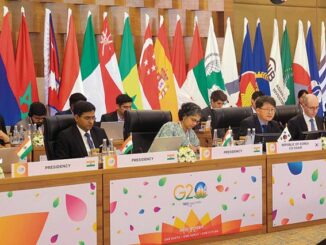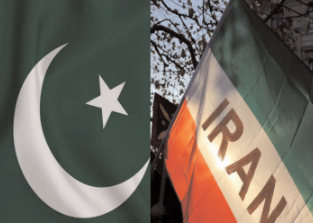
“India, too, must think creatively and adapt to the changing global trade dynamics. For decades, its high tariff walls were justified to protect domestic industries under the Five-Year Plans envisioned by Jawaharlal Nehru. That strategy worked: India built everything from safety pins to airplanes, became self-reliant, and transformed from a food-deficient to a food-exporting nation. How, then, can we fault others for pursuing similar protectionist policies today? It’s time for India to rethink its strategies and find a balance between protectionism and global trade.”

There is an ongoing discussion these days about whether the Indian diaspora has remained silent on tariffs and other U.S. policies that have hurt India. The Trump administration’s imposition of nearly 50% tariffs on most Indian goods imported to the United States has had a devastating effect on sectors such as textiles, shrimp, and cut diamonds. The recent $100,000 fee on new H1B visa issuance has only added fuel to the controversy.
Although domestic political considerations may have driven these tariff policies, their application worldwide appeared to be without clear policy standards, often arbitrary, abrupt, and inconsistently justified. Economist Jeffrey Sachs has argued that many of the tariffs imposed by the Trump administration exceeded the president’s lawful authority, calling them “delusional” and unlikely to reduce either trade or budget deficits in any meaningful way.
Nevertheless, tariffs are here to stay, and nations around the world, whether they like it or not, must learn to navigate them. Export-driven economies, including America’s closest allies, have been hit hard. The European Union, Japan, and South Korea reluctantly reached trade deals with Washington despite deep dissatisfaction, reflecting the leverage the U.S. still commands in global commerce.
India, too, had an early opportunity to negotiate a similar agreement that might have averted the present predicament, but instead chose to walk a diplomatic tightrope. Understandably, India had to protect its farmers and guard against U.S. agricultural imports that could undermine its rural economy. Yet, in every negotiation, there must be give and take, and perhaps India underestimated the Trump administration’s resolve to reshape global trade on what it viewed as a more level playing field.
More than anything else, the situation exposes the shortcomings of the Modi–Jaishankar statecraft, which has failed to advance India’s interests on the world stage. The recent Indo–Pak conflict revealed a sobering truth: in times of crisis, India stands largely alone. Despite global condemnation of the terrorist attack in Pahalgam, Kashmir, only Israel offered unequivocal support, while most nations maintained diplomatic silence.
India’s ambiguous stance within BRICS, a group that includes Brazil, Russia, India, China, and South Africa, may also complicate its strategic relationship with the United States. Although New Delhi insists it does not seek to undermine the U.S. dollar, Washington remains wary of BRICS-level financial initiatives led by China and Russia that aim to reduce dependence on the dollar. India advocates gradual reforms, such as local currency settlements, without challenging the dollar’s dominance, yet the rhetoric emerging from BRICS summits continues to unsettle U.S. financial circles. This ambiguity in India’s stance within BRICS, balancing its relationship with the U.S. and its aspirations for a more multipolar world, poses a challenge for its foreign policy.
Today, around 58–60% of global foreign exchange reserves remain denominated in U.S. dollars, compared to less than 3% in Chinese yuan. The dollar’s dominance is rooted in America’s economic scale, deep capital markets, and the global trust in its institutions: a legacy of the Bretton Woods system. Yet beneath that veneer of stability, the U.S. faces sobering economic realities. As of September 2025, the national debt has soared to $37.85 trillion, while the 2024 trade deficit stood at $918.4 billion. Mounting interest payments consume an ever-larger share of the federal budget, limiting investments in infrastructure, education, and defense. Persistent deficit spending fuels inflation and erodes living standards, raising questions about long-term fiscal sustainability.
The Indian diaspora in the United States, a testament to human resilience, has long sought opportunity and a higher standard of living and has largely achieved it through hard work and discipline. Naturalized citizens of Indian origin have pledged allegiance to their adopted homeland, yet their emotional ties to India remain strong. They send back nearly one-third of India’s total remittances each year, a lifeline for millions.
However, unlike Non-Resident Indians in the Gulf, these immigrants are not looking back. Their U.S.-born children rarely share the same depth of attachment to their ancestral land. Their primary concern is the economic stability of America. When multinational corporations exploit the H1B visa system to import low-wage labor at the expense of local graduates, disillusionment grows. The unemployment rate among computer science graduates, at 6.1%, underscores this frustration. In the 1970s and 1980s, U.S. tech companies routinely trained domestic graduates, even those without engineering degrees; today, they depend on lottery-based recruitment abroad.
India, too, must think creatively and adapt to the changing global trade dynamics. For decades, its high tariff walls were justified to protect domestic industries under the Five-Year Plans envisioned by Jawaharlal Nehru. That strategy worked: India built everything from safety pins to airplanes, became self-reliant, and transformed from a food-deficient to a food-exporting nation. How, then, can we fault others for pursuing similar protectionist policies today? It’s time for India to rethink its strategies and find a balance between protectionism and global trade.
Meanwhile, America’s Midwest has become a rust belt of ghost towns —a haunting monument to its industrial past. Rows of shuttered factories, silent assembly lines, and empty main streets mark the decline of the middle class that once anchored American stability. Much of that industrial wealth has since migrated offshore, fueling growth in distant economies even as it hollowed out communities at home. Economic gains now accrue largely to the wealthy, while younger generations struggle for the security once taken for granted. The resulting sense of insecurity fuels populist anger on both the left and the right, deepening divisions and eroding the democratic center that long kept the nation balanced.
Amidst these challenges, the United States and India still share many commonalities. Both are large, pluralistic democracies rooted in constitutional principles and the rule of law. Both share a restless entrepreneurial spirit and a belief in the power of innovation. These shared values form the foundation for a relationship that transcends transactional politics. Let both nations build on this strategic partnership and friendship, overcome temporary differences, and work together to reach a trade agreement that is not just quick but also fair and equitable, reflecting the principles of justice and fairness in international relations.
(George Abraham is a former Chief Technology Officer at the United Nations. He is Vice Chair of IOC USA. He can be reached at gta777@gmail.com)





Be the first to comment